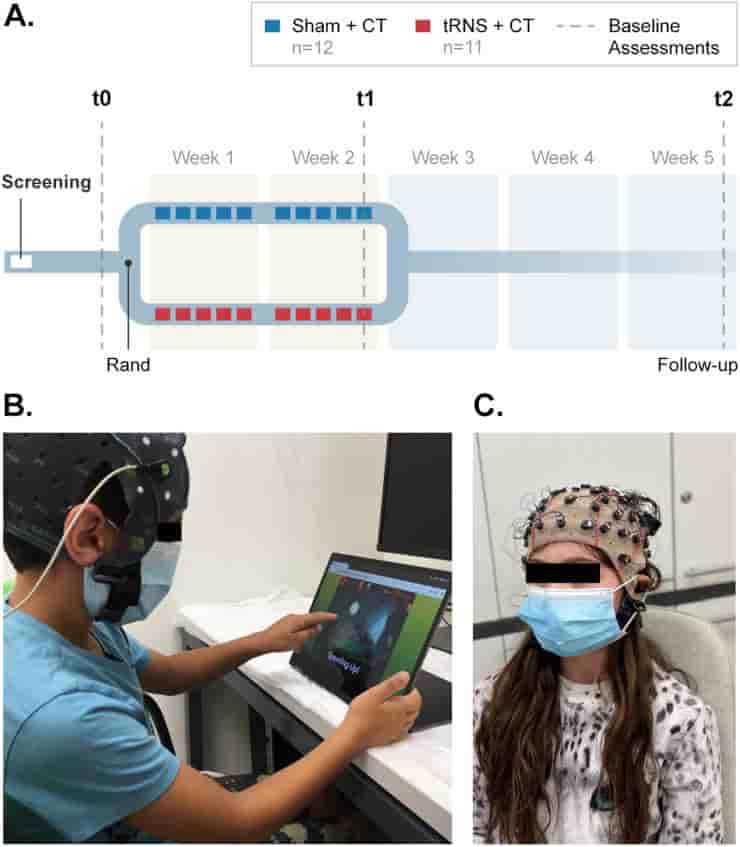According to new research, transcranial random noise stimulation in combination with cognitive training could significantly improve symptoms of attention deficit hyperactivity disorder (ADHD) in children.
Researchers set out to see if a novel form of brain stimulation that involves a mild electrical current on the brain through two electrodes during cognitive training can improve ADHD symptoms in a clinical trial involving 23 unmedicated children (six to 12 years old).
The study found that after a two-week program of Transcranial Random Noise Stimulation (tRNS), 55% of children showed significant clinical improvements in ADHD symptoms, as reported by their parents. During cognitive training, this was compared to 17% in the control group, which received a placebo of sham brain stimulation.
ADHD is a brain condition that has impacts on people’s attention, activity, and impulsiveness. Around 5.2% of children worldwide are affected by the condition, which typically manifests as difficulties with focus, memory, and self-control.
Transformative Potential
The study, led by researchers at the University of Surrey and the Hebrew University of Jerusalem, also discovered that these improvements were sustained three weeks after treatment ended. 64% reported clinically meaningful responses to the treatments compared to 33% in the control group.
“I believe that the scientific community is duty-bound to investigate and develop ever more effective and longer-lasting treatments for ADHD. The findings we demonstrate in our study suggest that a combination of transcranial direct current stimulation, which is shown to be safe with minimal side effects, has the potential to transform the lives of children and their families,”
said Professor Roi Cohen Kadosh, co-lead of the study, and professor of cognitive neuroscience at the University of Surrey.

(B) An example of a tES + CT session. Children sat in front of the tablet which delivers the CT, while receiving tES (active or sham) for 20 min each session.
(C) An example of RS-EEG recording session, in which EEG is recorded from children at rest. Pictures of children are included with written permission from participants and their parents. CT = cognitive training. Rand = randomization.
Credit: Transl Psychiatry 13, 271 (2023) CC-BY
The findings of this proof-of-concept study, combined with previous findings using tRNS, give us hope that non-invasive brain stimulation will be able to provide an alternative to medication as a treatment pathway for children in the future.
“However, our important test will be the results from a multi-center clinical trial with a larger sample that we will start soon. If successful, this approach will be approved as a medical device for ADHD by the United States Food and Drug Administration,”
Roi Cohen Kadosh added.
Lasting Changes
The researchers also noticed changes in the children’s brain electrical activity patterns after the treatment, and these changes lasted even at the three-week follow-up.
“This is an important first step in offering new therapeutic options for ADHD. Future studies, with larger and more varied samples, should help establish this as a viable therapy for ADHD, and help us understand the underlying mechanisms of the disorder,”
said Dr. Mor Nahum, co-lead of the study and Head of the Computerized Neurotherapy Lab at the Hebrew University.
If the results are replicated in larger studies, the team believes they will be able to offer a novel, promising, non-invasive, and safe treatment to a large number of children and their families, not only in the field of ADHD but also in other neuro-developmental disorders.
ADHD is one of the most prevalent neurodevelopmental disorders affecting children worldwide. Medication for the condition improves a child’s attention span and overall mood; however, there may be side effects, such as headaches and loss of appetite in some cases.
“There is therefore a pressing need for developing and testing novel, non-pharmacological interventions for ADHD. Results from the current proof-of-concept study provide a preliminary direction towards a novel intervention in pediatric ADHD,”
said Ornella Dakwar-Kawar, a post-doctoral researcher at The Hebrew University of Jerusalem.
Transcranial Random Noise Stimulation (tRNS) is a more novel form of transcranial electrical stimulation in which stimulation is delivered through both electrodes and presumably amplifies neural responses via the stochastic resonance mechanism.
Compared to transcranial direct current stimulation, which employs one excitatory and one inhibitory electrode, tRNS employs two excitatory electrodes, making it less sensitive to cortical folding and reducing the potential impact of anatomical differences between participants.
Reference:
- Ornella, DK., Noam, M., Shachar, H. et al. Transcranial random noise stimulation combined with cognitive training for treating ADHD: a randomized, sham-controlled clinical trial. Transl Psychiatry 13, 271 (2023).
